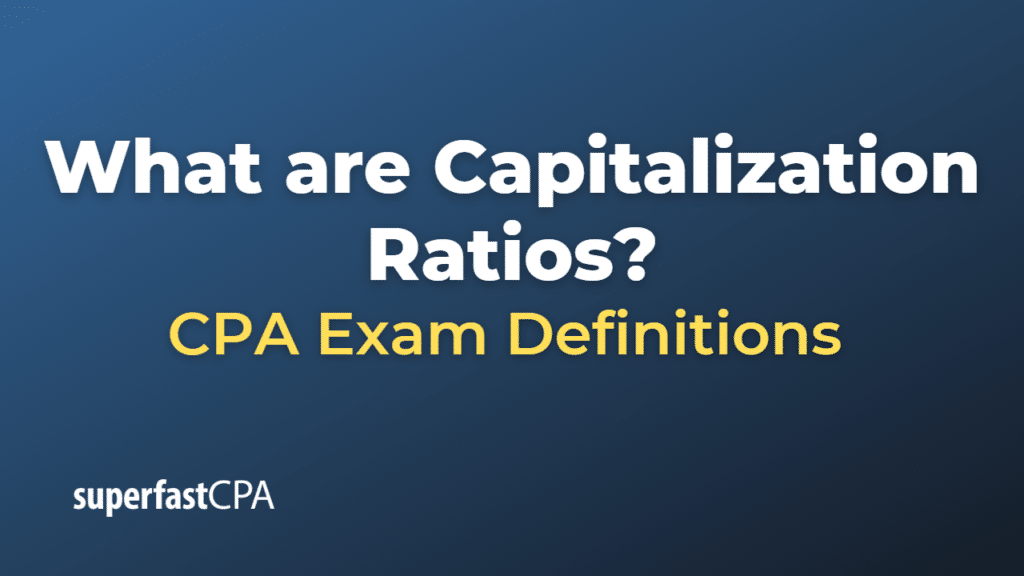Capitalization Ratios
Capitalization ratios, also known as financial leverage ratios or solvency ratios, are financial metrics used to assess a company’s capital structure, which is the mix of its debt and equity financing. These ratios help investors, creditors, and analysts evaluate the company’s financial stability and risk profile by determining how reliant it is on debt financing compared to equity financing.
Some common capitalization ratios include:
- Debt Ratio: The debt ratio measures the proportion of a company’s total assets financed by its total debt (both short-term and long-term). A higher debt ratio indicates higher financial leverage and a greater reliance on debt financing.
Debt Ratio = Total Debt / Total Assets
- Debt-to-Equity Ratio: The debt-to-equity ratio compares a company’s total debt to its total equity, showing the relative proportions of debt and equity used to finance the company’s assets. A higher debt-to-equity ratio indicates higher financial leverage and potentially higher financial risk.
Debt-to-Equity Ratio = Total Debt / Total Equity
- Equity Ratio: The equity ratio measures the proportion of a company’s total assets financed by its shareholders’ equity. A higher equity ratio indicates lower financial leverage and a greater reliance on equity financing.
Equity Ratio = Total Equity / Total Assets
- Long-term Debt Ratio: The long-term debt ratio focuses on the proportion of a company’s total assets financed by its long-term debt. A higher long-term debt ratio indicates a higher level of long-term financial leverage.
Long-term Debt Ratio = Long-term Debt / Total Assets
Capitalization ratios provide valuable insights into a company’s financial health, risk profile, and ability to meet its debt obligations. Generally, companies with higher capitalization ratios are considered to be more leveraged and potentially riskier investments, as they may have a higher likelihood of defaulting on their debt. However, it’s essential to consider other financial metrics and perform a comprehensive analysis when evaluating a company’s overall financial health and risk profile.
Example of Capitalization Ratios
Let’s consider a fictional company called “TechWave Inc.” to illustrate the calculation of capitalization ratios. The following financial information is available for TechWave Inc.:
- Total Assets: $1,000,000
- Total Debt: $400,000 (Short-term Debt: $100,000; Long-term Debt: $300,000)
- Total Equity: $600,000
Using this information, we can calculate the capitalization ratios for TechWave Inc.:
- Debt Ratio: Debt Ratio = Total Debt / Total Assets = $400,000 / $1,000,000 = 0.4 or 40%
TechWave Inc.’s debt ratio of 40% indicates that 40% of its total assets are financed by debt.
- Debt-to-Equity Ratio: Debt-to-Equity Ratio = Total Debt / Total Equity = $400,000 / $600,000 = 0.67 or 67%
A debt-to-equity ratio of 67% implies that for every dollar of equity financing, TechWave Inc. has $0.67 of debt financing.
- Equity Ratio: Equity Ratio = Total Equity / Total Assets = $600,000 / $1,000,000 = 0.6 or 60%
TechWave Inc.’s equity ratio of 60% indicates that 60% of its total assets are financed by equity.
- Long-term Debt Ratio: Long-term Debt Ratio = Long-term Debt / Total Assets = $300,000 / $1,000,000 = 0.3 or 30%
A long-term debt ratio of 30% means that 30% of TechWave Inc.’s total assets are financed by long-term debt.
These capitalization ratios can help investors, creditors, and analysts assess TechWave Inc.’s financial stability and risk profile. For instance, a debt ratio of 40% might be considered relatively moderate, depending on the industry and company size. It’s essential to compare these ratios to industry benchmarks and consider other financial metrics to evaluate the company’s overall financial health and risk profile comprehensively.













